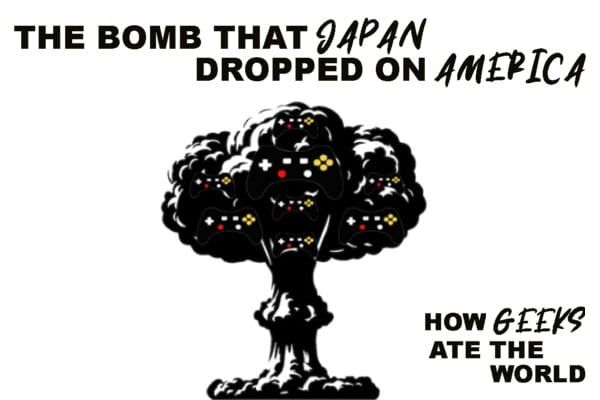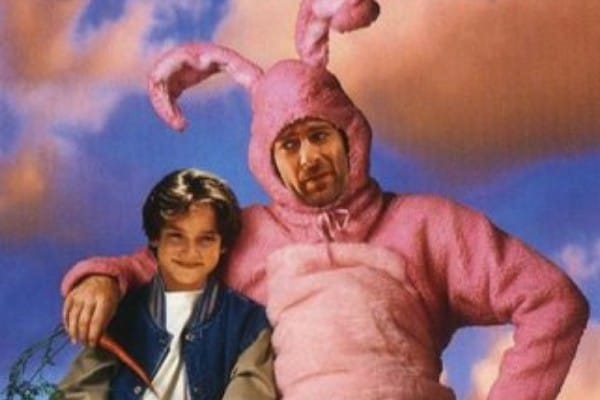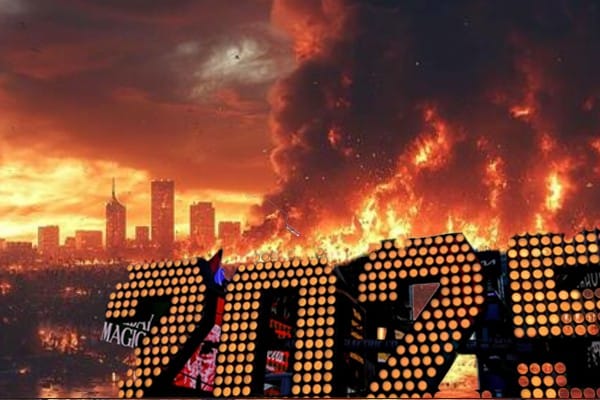🔒 How Geeks Ate the World: The Bomb that Japan Dropped on America
The Eastern origins of anonymous Western online culture

How Geeks Ate the World is the working title of a book that I’m writing, exploring the development of reactionary movements in geek culture (media, tech, and hobbies) since the internet era, and how these movements have come to dominate real world politics in pretty horrifying ways.
I will be publishing chapters and essays related to this project for paying subscribers around once a month. Unlike my regular newsletter, these essays will remain paywalled.
Episode 1 - How Geeks Ate the World
Episode 2 - Demons of Suspicion
Episode 3 - Backward Male
Episode 4 - The Californian Ideology
Episode 5 - Something Old, Something New, Something Rotten, & Something Awful
👉Episode 6: The Bomb that Japan Dropped on America
The emergence of the internet came at a time when Japanese pop culture was infiltrating the West at a heightened pace, particularly animation. United States broadcasters had been importing anime for some time, but, concerned that audiences wouldn’t accept foreign media, they often dubbed and altered the program to remove any indication of its origin.1
The phenomenal success of Star Wars in 1977 created a strong market demand for similar media that couldn’t be immediately satisfied by American producers, and so the new Western hunger for epic battle fantasy was satiated in part by importing media from Japan. Most notably, Battle of the Planets, the Western title given to Kagaku Ninja-tai Gatchaman (“Science Ninja Team Gatchaman”), was American audiences’ first significant exposure to Japanese anime—even its American distributers couldn’t understand the language, so when dubbing it into English they interpreted the plot visually. As such, the story was radically Westernized, and other alterations were made deliberately to make it feel more like Star Wars, including moving the setting from Earth to a fictional planet.2
In a way, one that American youth weren’t even aware of, the arrival of anime in America was like a long lost relative coming home. The Japanese artist Osamu Tezuka, creator of Astro-Boy as well as many other legendary franchises, is popularly regarded to be the “father of manga,” but the single greatest influence on his artistic development was Walt Disney.3
Japanese comics of course far predate Disney, as do American comics. The first artwork that modern scholars consider to be categorically manga is an 11th century series of scrolls called Choju-jinbutsu-giga—“Scrolls of Frolicking Animals and Humans”—that bears an odd resemblance to modern anthropomorphic-animal art like Frog and Toad. The scrolls, which unfurled from right-to-left and to reveal a series of scenes very similar to comic panels,4 and were likely a satire of contemporary politics with real historical figures switched out for animals in order to evade censorship.5 This would prove the start of a long tradition of Japanese artists fighting for freedom of speech and expression and dodging state censors through simple innuendo.
The modern history of both Japanese and American popular comics and animation, however, is a complex relationship of give-and-take. In what some might view as an unjust but darkly poetic turnaround from Disney forming the basis of Osamu Tezuka’s style, Disney would later be accused of stealing one of his characters, Kimba the White Lion, as the basis of Simba, the Lion King.6
The reciprocal nature of American and Japanese culture isn’t restricted to animation. The tides of both cultures have been pulled by each other’s gravity in many different ways since World War II, and for the next 30-40 years after the war’s end, this cultural exchange was mostly imposed on Japan from the USA and the West. The most sudden major transformative shock of this period was, of course, the atomic bomb, the trauma of which has echoed in ripples and waves through Japanese culture ever since. The “kaiju” phenomenon—giant monster movies, beginning with 1954’s Gojira (Godzilla)—were a direct expression of this trauma that could not, for a time, be expressed literally due to censorship by the Western occupation.
Even then, much of the inspiration came from American monster movies. The Beast from 20,000 Fathoms, a 1953 American stop-motion movie based on a Ray Bradbury story and depicting a giant lizard rampaging through New York, is the most clear visual inspiration,7 but special effects artist Eiji Tsuburaya was particularly enthralled with King Kong. The monster was envisioned as Kong, but emerging from the ocean, thus the name “Gojira,” a combination of the Japanese words for “gorilla” and “whale.” Literally, the King Kong of the sea.8
Even Pikachu, the lovable electric mouse at the center of the Pokémon franchise of games, anime, and manga, shares an etymology with the Japanese word for a nuclear blast: “pikadon.”2 Though the creators of Pokémon may not have been trying to allude directly to the nuclear blast—the prefix “pika” is a memetic word meaning "sparkle; glitter; flash; shine brightly”— 9its horrors echo deeply through culture.
Just as in the West, Japan has had its own troubled relationship with masculinity, both reflected in and informed by its popular culture. Culturally and historically, it’s common to cite bushido, the warrior code of the samurai, as an important reference for the traditional Japanese masculine. However, much of the modern understanding of bushido comes from the work of 19th century Japanese scholar Nitobe Inazo, who wrote a popular book in English that heavily emphasized and exaggerated the ways in which this discipline was specifically masculine, and by extension, how masculinity formed the soul of the nation of Japan. It has been theorized this was, at least in part, a defensive response to the European tendency to describe the Japanese as a feminine nation and culture.10
The abolition of the samurai, a consequence of the Meiji Restoration through which Nitobe lived, was itself an imposition of Western pressure. Until then, Japan had been a fiercely isolationist feudal society with only a loose national identity, its power divided among the military lords—the shoguns—with the samurai as their enforcers. But the West’s imperial hunger during the 19th century began to close in on Asia.11
In today’s ultra-consumerist society we tend to project our fears of capitalism run amok onto dystopian future fiction—the sci-fi warnings of Ridley Scott and Paul Verhoeven of corporations becoming our overlords—but we often forget that this idea has historical precedent, and we need not look into our distant future so much as our recent past. The 18th and 19th centuries saw the British East India Company—sort of the seafaring age equivalent of Amazon—rise to such a power that it began to act as a sovereign entity in its own right (also, arguably, like Amazon).
In the age of mercantilism, these companies were permitted such immense power and agency if their activity abroad worked for the greater enrichment of the British Empire. By the 1850s, the Company was not only waging its own wars but overthrowing and occupying nations. Its insatiable pursuit of profit led to the Opium Wars against China and the British seizure of both Hong Kong and the entire Indian subcontinent.12
It was only a matter of time before the West turned its sights entirely upon Japan, the singularly defiant and isolated outpost of unique Eastern culture, ripe for trade, but stubborn. Attempts by the British, the Russians, and the Dutch to penetrate its isolationist policy with trade negotiation were met with very limited success. The Americans, under the command of the otherwise historically forgettable President Millard Fillmore, opted to open trade with Japan under the threat of physical violence.11
These foreign threats were the catalyst Japan needed to reconcile its disparate feudal system under the unitary control of a single power—Emperor Meiji. The Meiji Restoration effectively ended the samurai, who by this point in history had been relegated to little more than civil servants anyway.13 Much of their influence would pass from societal reality into the bushido legend, although remnants did remain, in the form of shizoku, or “warrior families,” who were still distinguishable from commoners on official registers. This would be the case until 1947, two years after the nuclear blast. Though coincidental, it is notable, for our purposes, to mention that the end of the samurai also coincided closely with the invention of the computer.14
Japan adopted a new constitution modelled after those in Europe, establishing a parliamentary governance system. On paper, the Emperor’s powers were ostensibly defined through the rule of law rather than the divine right of kings, but in practice, fostering the public perception of the Emperor as an infallible central authority, sacred under the state Shinto religion, was paramount to maintaining a strong national solidarity. For its limited movement toward Western styles of governance, one should not make the mistake of thinking that this was a system designed in harmony with liberal feminism. The monarch could only be male, as could the military. While women did have rights, upon marriage they became legally subordinate to their husbands, obtaining the same legal status as a minor or a dependent.15
The transformation of Japan during the Meiji Restoration from feudalism to a capitalist industrial world power was rapid and dramatic, and though it was presented to the public as a return to an idealistic—largely fictional—cultural past, it still required social suppression on a large scale.16 Sadly, a basic parliamentary system was not the only concept that Meiji Japan inherited from the West. It adopted an insatiable hunger for resources that quickly turned its sights on its closest neighbors. You don’t need a historian to tell you how that ended:
Pikadon, pikadon.
The United States punished Japan for its isolationism, and then, less than a century later, punished it for its expansionism. Feudalism is, by no means, a desirable system of governance from a human rights standpoint, but this early example of what would become a long tradition of America imposing capitalism and liberal democracy on foreign nations at gunpoint produced a lesson from which it has learned little to this day.
Continued after the paywall: Japanese popular culture after the war: the otaku, its surprising connections to Japanese terrorism, and its eventual influence on Western internet culture.




